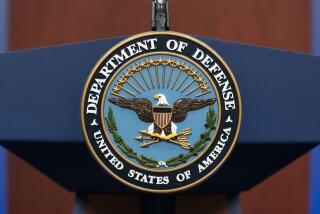Desert Shield Death Toll Considered Low So Far : Military: Commanders say 86 fatalities in or near the area of operations are understandable, given the intensity of the buildup.
- Share via
RIYADH, Saudi Arabia — Although not a shot has been fired in anger, Operation Desert Shield has already claimed the lives of 52 Americans in the Persian Gulf region and 34 more in two accidents outside the military theater.
The 86 dead is almost four times the fatalities that the United States suffered in the invasion of Panama in 1989, but military commanders say the casualties are relatively low given the intensity of the buildup and the dangers inherent in preparing for combat.
Defense Secretary Dick Cheney said in Dhahran last week that while there is no such thing as an acceptable death rate and every death is cause for concern, the safety record has been good considering the hazards involved--long, physically tiring workdays, live-fire exercises, work with heavy equipment and driving and flying over unfamiliar terrain.
Commanders in the field contend that the death rate is comparable to many peacetime military operations. Last year, the military services recorded 1,597 noncombat deaths, or about 6.2 per month per 100,000 troops, Pentagon officials said. Desert Shield has produced a rate of something under eight per 100,000.
Of the thousands of injuries, most were sustained during sports and recreational activities.
The most recent Desert Shield deaths occurred over the weekend. The Pentagon announced Monday that five U.S. service people had died in separate incidents in the Persian Gulf, including two killed in gunshot accidents. Two others died in accidents not involving firearms, and a fifth died of an apparent heart attack.
The worst accident in the gulf region was the Oct. 30 rupture of a steam line on the Iwo Jima that claimed the lives of 10 sailors. Eight more servicemen died in the collision of two helicopters. The next largest toll has come from vehicular accidents, the leading cause of deaths at U.S. bases in time of peace.
The Air Force suspended all helicopter training flights in October to review safety procedures after a rash of accidents. At the time, aviators appeared to be having difficulty adjusting to night-vision goggles. Ground troops also have found desert driving dangerous, particularly at night, when dunes and other obstacles that can overturn a vehicle are not easily discernible.
U.S. officers believe that the military’s ban on alcohol, instituted in deference to the customs of this conservative Islamic society, has had a significant role in reducing off-duty accidents. The ban has also dramatically lessened discipline problems, they said.
“If anything, the guys out here are having far less problems than they do at home,” said Lt. Cmdr. Terry Aragoni, a Navy surgeon. “There’s no alcohol, no women, nothing that can get them into trouble. It’s really a very tame environment right now. Back home at Camp Pendleton, on a Friday night, you’d spend half the night sewing up people who had been in automobile accidents.”
Although eight paratroopers from the 101st Airborne Division were hospitalized this month for methanol poisoning after drinking homemade alcohol, beer and alcoholic beverages are basically non-existent at U.S. military facilities here. The prohibition has resulted in surprisingly few complaints.
“It’s a hundred degrees and you’d expect people to say, ‘Boy, I wish I had a beer,’ ” said Lt. Col. Richard Kelly, a Marine battalion commander. “But you just never hear that. I don’t think the men even miss it.”
Of the fatal accidents outside the theater, two have accounted for 34 deaths. Thirteen servicemen, mostly Texas reservists, died in August when their C-5A transport plane crashed on takeoff in Germany on its way to the gulf. At least 20 sailors drowned last month when an Israeli ferry carrying servicemen from shore leave back to the aircraft carrier Saratoga sank in the Mediterranean.
In the gulf region, the absence of alcohol has not only prevented off-duty accidents but has contributed to what may be the lowest rate of disciplinary action ever recorded during a sustained U.S. military presence.
More to Read
Sign up for Essential California
The most important California stories and recommendations in your inbox every morning.
You may occasionally receive promotional content from the Los Angeles Times.













